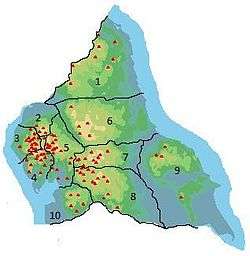Hard Knott
| Hard Knott | |
|---|---|
 Hard Knott Location in Lake District, UK | |
| Highest point | |
| Elevation | 549 m (1,801 ft) |
| Prominence | 154 m (505 ft) |
| Parent peak | Scafell Pike |
| Listing | Marilyn, Wainwright |
| Coordinates | 54°24′37″N 3°11′11″W / 54.41032°N 3.18634°WCoordinates: 54°24′37″N 3°11′11″W / 54.41032°N 3.18634°W |
| Geography | |
| Location | Cumbria, England |
| Parent range | Lake District, Southern Fells |
| OS grid | NY231023 |
| Topo map | OS Landrangers 89, 90, Explorer OL6 |
Hard Knott is a fell in the English Lake District, at the head of Eskdale.
Hard Knott is a notorious hill climb on the annual coast to coast cycle ride. Most riders can be found walking rather than riding. This is mainly due to severe gradients of up to 33% along the route.
Topography
The headwaters of the River Esk and the Duddon are separated by a ridge falling south west from the summit of Crinkle Crags. This line of high ground continues over many twists and turns for 15 miles (24 km), finally meeting the sea on the slopes of Black Combe. From Crinkle Crags the first fell on this ridge is Hard Knott, followed by Harter Fell and Green Crag. Alfred Wainwright did not include the remainder of the ridge in his influential ‘’Pictorial Guide to the Lakeland Fells’’, but later guidebook writers have disagreed, adding Great Worm Crag, Yoadcastle, Whitfell, Buck Barrow, Black Combe and the low hills around Devoke Water to their main volumes.[1][2] Wainwright himself later relented and included these lesser hills in a supplementary volume, The Outlying Fells of Lakeland.
From the main ridge of Crinkle Crags a low saddle juts out to the west in the vicinity of the southernmost Crinkle. This separates the basin of upper Eskdale from the head of the small marshy valley of Moasdale, down which the Moasdale Beck flows south to join the River Duddon at Cockley Beck. To the west of the saddle the ridge turns southward and gains height, rising over a series of rocky knolls to the summit of Hard Knott. The Moasdale side has gentle gradients but the western flanks above the Esk are fringed with crags. One feature on this side is the Eskdale Needle, (also known as The Steeple) a finger of rock detached from the main face.[3] As the Esk and Moasdale Becks diverge, the girth of the fell increases, until a pair of side valleys intrude to nip off its southward progress. These streams, both named Hard Knott Gill, fall from either side of Hardknott Pass, beyond which the ridge climbs again over a series of crags toward Harter Fell.
The Hardknott Pass joins Eskdale with the Duddon Valley. There is a steep single-track road over the pass with gradients of up to 30% (1 in 3), reaching a maximum height of 393 metres (1,289 ft). The Hardknott Roman Fort stands at a height of about 200 metres (656 ft) on the lower slopes of the western ridge as it descends into Eskdale. A Roman road from Ravenglass to Ambleside once crossed the pass, although by a slightly different route.
Geology
Rhyolitic lava-like tuff of the Bad Step Tuff forms the summit rocks with the dacitic lapilli-tuffs of the Lincomb Tarns Formation to the north west. Border end shows outcropping plagioclase-phyric andesite lavas of the Birker Fell Formation.[4]
Summit
Hard Knott reaches a height of 549 metres (1,803 feet), the summit knoll bearing a cairn. There are other named tops on the ridge in addition to the summit, with Yew Bank to the north and Border End to the south. Hard Knott is famous for its superb view of the Scafell massif to the north, while Harter Fell dominates the vista to the south. For a fabulous view of Eskdale it is recommended that the walker visits Border End half a mile to the south of the main summit.[3][5]
Ascents
The fell is usually climbed from the top of the Hardknott Pass where there are several parking spaces. It is also possible to begin the ascent from the foot of the pass in Eskdale, although this will triple the length of the walk and the height gained. However, the best plan is probably to climb Hard Knott in conjunction with the neighbouring fell of Harter Fell making a horseshoe walk starting and finishing in Eskdale. From the top of the pass it is a short ascent to the fell summit following an electric fence that skirts to the right of the dangerous looking Raven Crag and takes the walker to the summit in a short time. Other possible routes include a pathless ascent from the Esk via The Steeple, a circuitous walk via the head of Moasdale and an ascent of the eastern flanks via Dod Pike.[3]
References
- ↑ Richards, Mark: Southern Fells: Collins (2003): ISBN 0-00-711367-6
- ↑ Birkett, Bill: Complete Lakeland Fells: Collins Willow (1994): ISBN 0-00-218406-0
- 1 2 3 Richards, Mark: Mid-Western Fells: Collins (2004): ISBN 0-00-711368-4
- ↑ British Geological Survey: 1:50,000 series maps, England & Wales Sheet 38: BGS (1998)
- ↑ Alfred Wainwright: A Pictorial Guide to the Lakeland Fells, Book 4: ISBN 0-7112-2457-9

